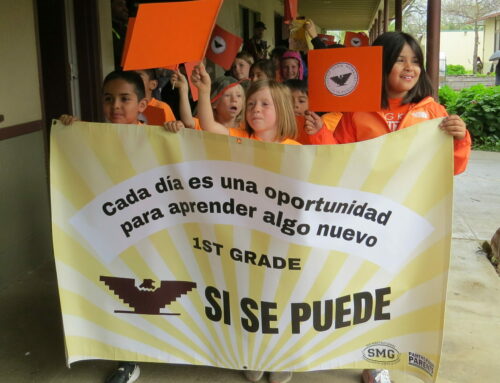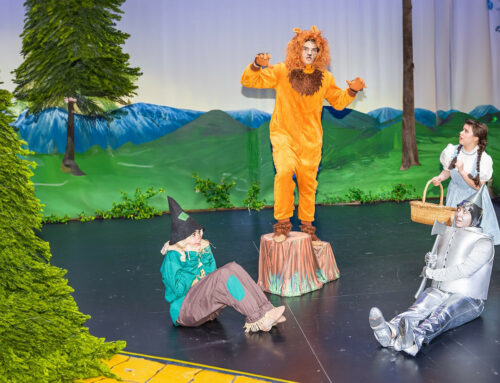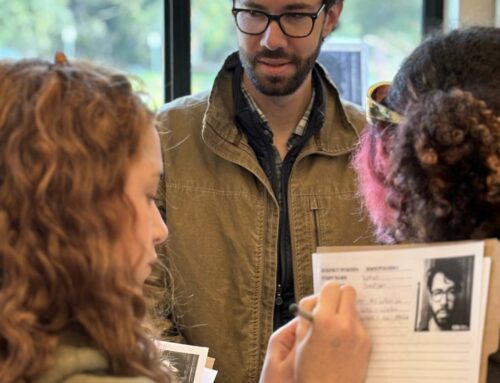Morgan Hill youngsters will travel to Japan in 2016
Published in the Sept. 16-29, 2015 issue of Morgan Hill Life
By Kylie Sullivan, Rachael Chiang-Perdue, Aaron Osborne

Photo by Marty Cheek
Japanese exchange students Runa Jahanbazi Gojani (left) and Kirari Watanabe (right) enjoy making face at the Fun in the Summer event.
Nine Morgan Hill middle schoolers learned about the Asian culture by interacting with young people from Mizuho, Japan, as part of a student exchange program last month. The students discovered the similarities between people living on both sides of the Pacific Ocean and found the biggest difference was the languages spoken.
The 10-day student exchange was done under the umbrella of the Morgan Hill Sister City nonprofit organization to engage youth interaction between Morgan Hill and Mizuho. The program alternates sending students every year between the two cities. Next summer, eight Morgan Hill student “ambassadors” will travel to Mizuho to represent the South Valley community.
Cindy van Rhijn’s daughter Marissa participated in the 2009 exchange program and she served as a chaperone on the trip. Van Rhijn is now co-chair with Mary Wakatsuki in the program.
“As our family integrated into Morgan Hill, we noticed not a lot of kids have that experience of visiting another country and discovering its culture,” she said.” I saw those eight (American students) that first went really blossom.”
Kylie Sullivan will be going to Mizuho next summer and the trip will be the first time she’ll travel outside the country.
“It’s unlike anything else that I’ve ever experienced,” she said. “Since I didn’t host a Japanese student, I’m hoping to make a connection with one of the students. I’m excited to visit their home.”
Eighth grader Aaron Osborne was excited when he heard the phone call message from the Morgan Hill Unified School District informing local families of the opportunity to host Japanese students this year as well as travel to Mizuho in 2016.
“One thing I learned from talking to the Japanese exchange students is that everything in Mizuho is very small compared to Morgan Hill’s large buildings and infrastructures,” said Osborne.

Photo by Marty Cheek
Ariana Arriola, with the city’s recreation department, standing, encourages Japanese exchange student Kanako Negishi while she performs situps during a contest at Galvan Park’s Fun in the Summer event.
Mizuho is in the Nishitama District of the Tokyo Metropolis and was founded Nov. 10, 1940 when four villages were merged. The community has a population of more than 34,000 living in an area of 6.5 square miles. Morgan Hill’s population is more than 40,000 living on nearly 13 square miles.
Rachael Chiang-Perdue thought it was fun hosting Japanese exchange student Runa Jahanbazi Gojani because her guest likes eating and wanted to try American foods. Hosting the Japanese student from Aug. 21 to Aug. 30 made Chiang-Perdue see her own community in a new light.
“It was funny that we live here and things that Runa noticed we never really had taken a note of,” she said.
Takaya Watanabe said he thought the biggest difference between Mizuho and Morgan Hill was the geographical sizes of the cities, with Morgan Hill being much bigger. His experience coming to California helped him to understand American culture better.
“Ever since I was 4 years old, I wanted to come to the United States,” he said. “I would watch movies in the theater and my desire just grew, so that’s why I applied to the program.”
He also was fascinated by the richness of the local history here, he said, commenting on a tour of the Villa Mira Monte history complex in Morgan Hill.
“I found it very interesting when we went to the Villa Mira Monte site,” he said. “I was fascinated when they showed us the old iron and sewing machines and all the old equipment and things like that.”

“Everything I see is new to me and different compared to Japan,” he said. “I love everything I see and smell and touch…. I like the fact I don’t have to remove my shoes when I enter the house.”
The Japanese students spent three mornings at various middle schools. Akasaka attended Britton and felt pleased by the friendly greeting he received, especially touched by the posters the school’s international club students made and hung up at the entrance to welcome him.
Kanako Negishi attended Martin Murphy and was impressed by the new Chromebooks the students have.
“It was such a great discovery for me that you guys are using more technology and everything,” she said. ‘I found that your learning process is very interesting and maybe a bit challenging, but it’s a great discovery for me. I like it.”
The host families and organizers took the Japanese students to the Santa Cruz Beach and Boardwalk, a San Francisco Giants game, the Monterey Bay Aquarium, the Golden Gate Bridge, as well as tours of Morgan Hill’s City Hall, and interaction with Youth Action Council students at the Summer Fun in the Park event at Galvan Park.
Nanami Saito was surprised by how much rural environment surrounds the South Valley region.
“I thought I was going to see high rises and big buildings, but instead I saw open space and hills and beautiful nature,” she said.
Kirari Watanabe was also pleased by how out-going American people are with each other.

She also recommended the Sister City student exchange program as a bridge building opportunity for the two countries.
“Even though we have technology and you can travel all over the world through Google in your home, it’s different when you actually physically come to the United States,” she said. “I think it’s a great experience and I will encourage my friends to travel here like I did.”
Jahanbazi Gojani attended three morning sessions at Charter School of Morgan Hill and enjoyed how different the classrooms were from her own school experience in Japan.

Christine Osborne, mother of Aaron Osborne, sees the Sister City exchange program as a good way to promote cultural awareness between young people by hosting a Japanese student of the same middle school age group as her son.
“The kids are maturing and realizing there is more of the world out there than just their little niche,” she said. “They interact and enjoy the same kinds of things. They like music and food and they certainly were interested in American pop-culture. They definitely like Taylor Swift.”
The eight Morgan Hill student ambassadors are now raising funds for their trip to Mizuho next summer. Last year’s trip cost each student about $2,000.
To provide a donation, make a tax-deductible check out to the Mizuho Student Exchange and email Cindy van Rhijn at [email protected] for a mailing address and to be put on a list for upcoming fundraisers.
Special thanks to Mayumi Swetland for translating the Mizuho students’ interviews from Japanese to English. This story was written with the help of Morgan Hill Life Publisher Marty Cheek.






